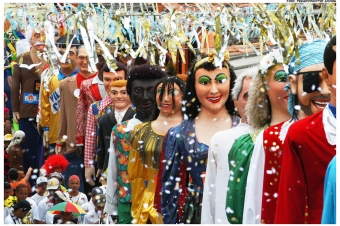Summary:
It is an activity that focuses on the relationship between artistic expression and legal forms, taking advantage of the artistic interpretation to demonstrate the difficulties of clearly separate fact, value and rule of legal interpretation. It is intended that students see art as index of ideological constructions and identify the problem of interpretation in arts and law. The dimensions of ethics and aesthetics are approached.
Objective:
- GENERAL GOALS: to help students realize the ideological assumptions in art and law and its relationship with interpretative models. In addition, it wants to offer different ways to compose this relationship between subject and world rights.
- SPECIFIC GOALS: to problematize the common sense on the right, activity related to the concepts of fact, value and norm.
- It is intended that students develop:
1) the perception that the look is built and an external object can even have different significance.
2) to reflect on the difficulties both regular facts of life as well as to interpret the norm.
Dynamics:
- TEACHING METHODS: Socratic dialogue in the strict sense, because the goal was that the student realized how build his own reasoning.
- REQUIREMENTS: there was no previous activity for the students because that was the first class of the course. In relation to the professor, the preparation consisted on the elaboration of sheet in tabular format, containing, in the first column, the numbers corresponding to the number of frames that will be displayed, in in the second column, the options "naked"/"nude" in all lines, and the third column, a field to be filled with a "reason" for that choice. The sheet was delivered to all present students. The professor sought the paintings in the Tate Gallery website (search filter to the XIX Century), among others. See:
<a href="http://www.tate.org.uk/art/search?gm=350&vid=1">Tate Gallery</a>
- INTRODUCTION TO THE DYNAMICS: The professor explained the debate, which became known as <i> The naked and the nude </ i>, in the UK during the XIX Century. He asked the students to analyze the paintings projected on slides, displayed for 30 seconds each. All students noted on the card are considered the framework "naked" and "nude" and filled in the field "reason", specifying the reason that made them decide between one or the other, being "naked" what the student considered pornographic and "nude" what he considered artistic nude. It is worth to clarify that it was not allowed to leave any field blank and the cards were not identified. At the end of this introduction, the cards were randomly redistributed, preserving the anonymity of the authors. The introduction of dynamic took approximately 25 minutes.
- DEVELOPMENT OF THE DYNAMICS: during the slides projection, the professor asked the students to individually fill out the card in the sequential order of presentation. After exposure of all frames, the professor collected the cards and after shuffles them, he redistributed randomly to the students, thus avoiding possible embarrassment and encouraging the participation. There was conducted a debate in class about the results of the cards from the views of the students and the professor. This stage lasted 25 minutes.
- END OF THE DYNAMICS: It was found the variation of both views on the construction of reasoning, the professor asked students to get together in groups of five people (the group composition in odd number is preferred). They should deliberate and elaborate a short text on a law article format in order to create parameters for what would be "naked" and "nude". The professor followed the discussions of the groups walking around the room, and then asked for a student from each group present the law text created. In the end, all the proposed law texts were discussed in class. This stage lasted 45 minutes
- ATTENTION IN THE CLASSROOM:
1) Be aware of the number and variety of pictures. The ideal is to show 12-14 frames with different and varied elements, changing scenarios (landscape, bedrooms, libraries, etc.), subject (containing men, women, men and women) etc. Before setting out the frames in the classroom, it is recommended that they are shown to other colleagues (men and women) to function as a control group, assisting in the choice of works in order to ensure diversity and the necessary precautions to implement the activity, because each one has a vision of "naked" and "nude". In addition, it should also consider the ethos of the educational institution to scale paintings which will be shown to students.
2) It is very important to keep in mind that the activity does not intend to discuss the framework itself, but the built view by the subject and how the same object can have different meaning for different people. It is possible to bring discussions of positivism, legal realism etc.
3) The professor does not need to be an expert in the arts (painting) to perform the activity.
Evaluation:
- FEEDBACK: the professor gave feedback on students' opinions during the debates and at the closure of each discussion.
- GRADE EVALUATION: there was a students' participation grade in the activity, which, however, did not seek to evaluate the speech or other action made by the students.
Observation:
Copyright from the cover page image:
The Orchard, Dod Procter, 1934, Photo: © Tate, London [2015]:http://www.tate.org.uk/art/artworks/procter-the-orchard-n05325






